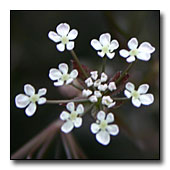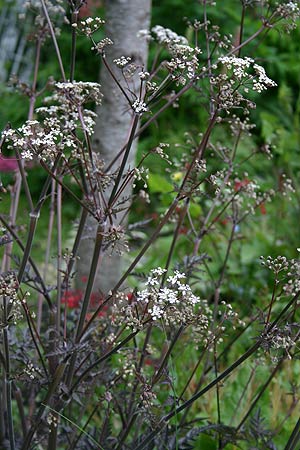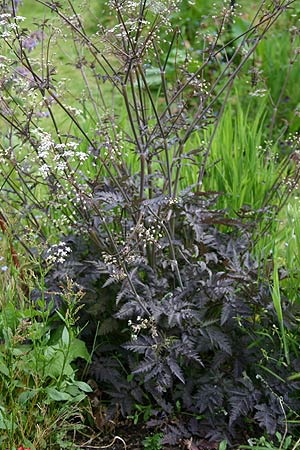Anthriscus sylvestris 'Ravenswing'
COW PARSLEY, LADIES ANNE LACE
Family: Apiaceae
Pronounced: an-THRIS-kus sil-VES-tris

Quick Jumps
Growing Guide
Rainy Side Notes
GROWING GUIDE

Origin:
Garden.
Plant Group:
Biennial or short-lived perennial.
Hardiness:
Sunset zones: 1-9, 14-24.
USDA zones: 7-10.
Heat zones: 10-1.
Mature size:
Height: 3 feet (1 m).
Width: 12 inches (30 cm).
Flowering period:
Late spring to summer.
Flowering attributes:
Umbels of small, white flowers with pink bracts.
Leaf attributes:
Deep purple, ovate, pinnatifid leaflets on dark stems.
Light:
Full sun to partial shade.
Soil:
Any well-drained soil.
Feeding:
No fertilizing is necessary.
Propagation Methods:
Succession sow seed in situ from early spring to midsummer.
Root cuttings in midwinter.
Pests and Diseases:
Slugs, snails and some caterpillars may be a problem for young plants. Powdery mildew may be a problem during summer.
Rainy Side Notes

Anthriscus sylvestris 'Ravenswing' has handsome, dark purple foliage and stems that are so dark they almost look black. When it blossoms, the white flowers stand out in stark contrast against the dark leaves. The color makes it perfect for a gothic garden; even the name 'Ravenswing' makes it a perfect fit for growing on the dark side of an Edgar Allan Poe garden.
Considered a biennial or short-lived perennial, the plant is a surprising addition to the herb garden. Like its relative parsley, the dark fern-like leaves make a handsome garnish; however, the taste of the plant isn't something I would write about.
Anthriscus will self-seed, although some of its offspring may spring up green. Weed the green ones out and keep the dark foliage seedlings. They are excellent cut flowers. Use them for fillers in bouquets as you would Queen Anne's lace.
Photographed in author's garden.

Gardening for the Homebrewer: Grow and Process Plants for Making Beer, Wine, Gruit, Cider, Perry, and More
By co-authors Debbie Teashon (Rainy Side Gardeners) and Wendy Tweton
Copyright Notice | Home | Search | Herbs

